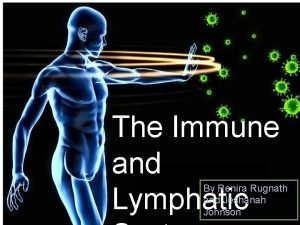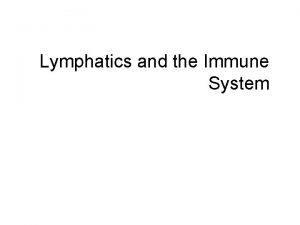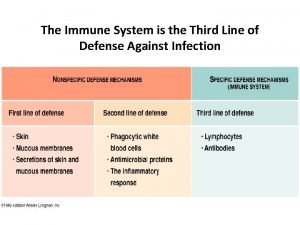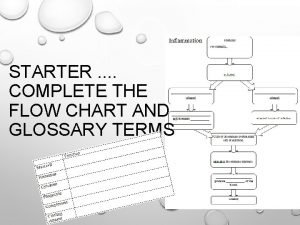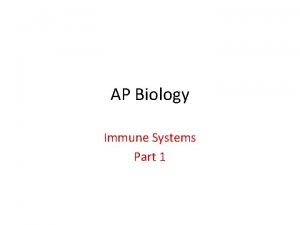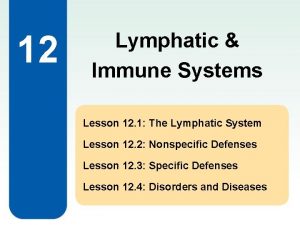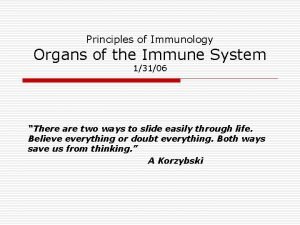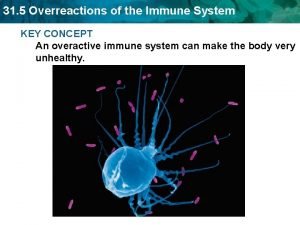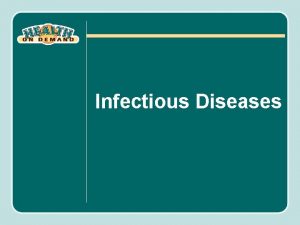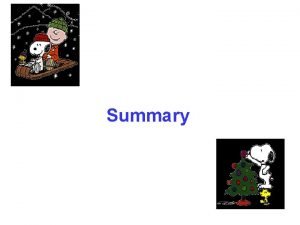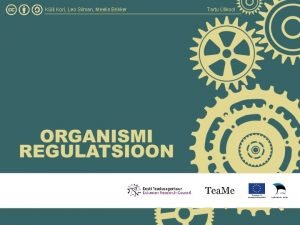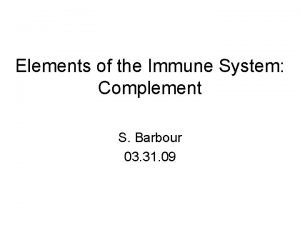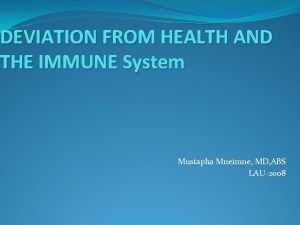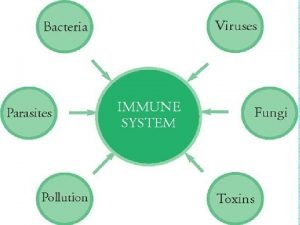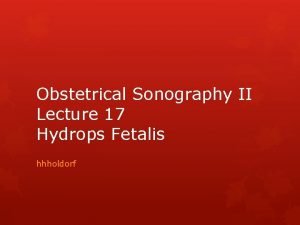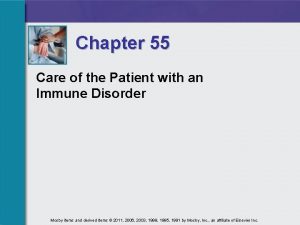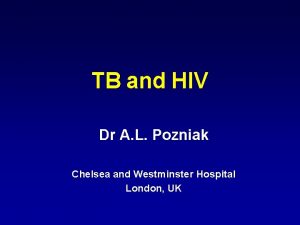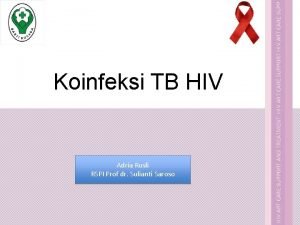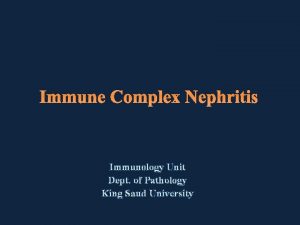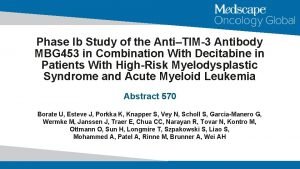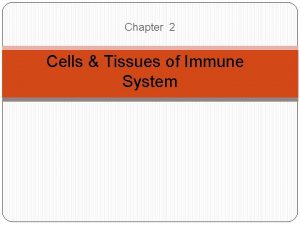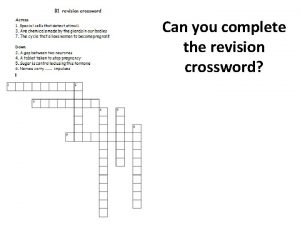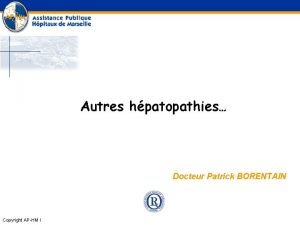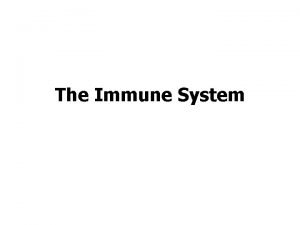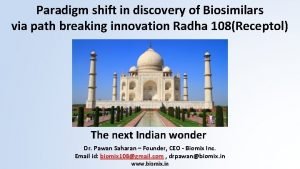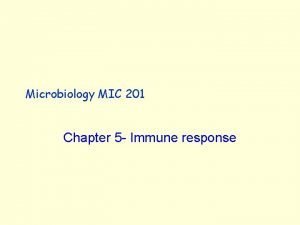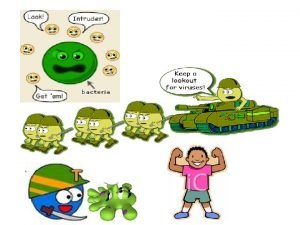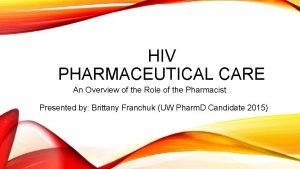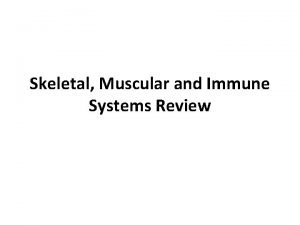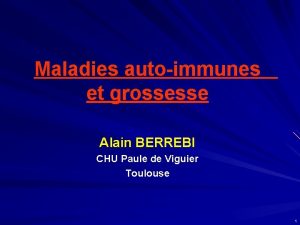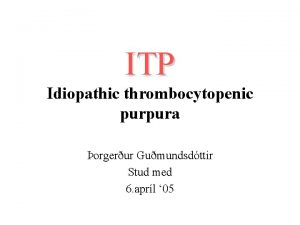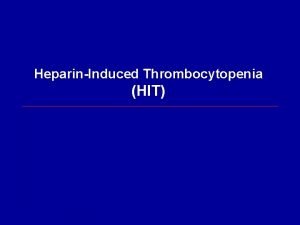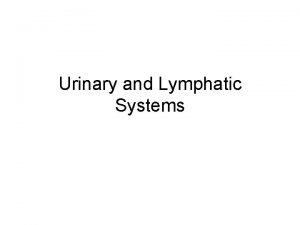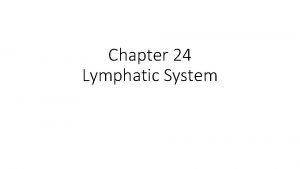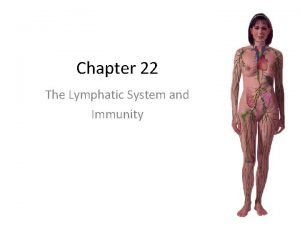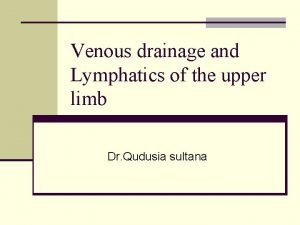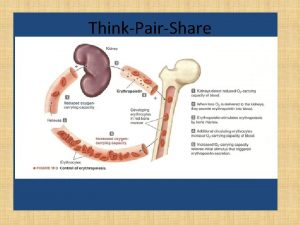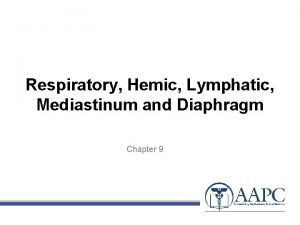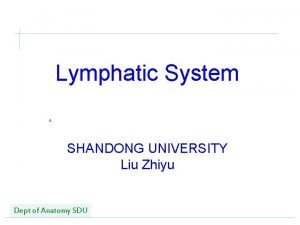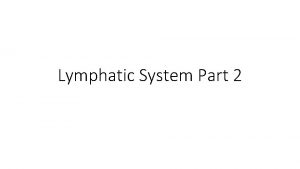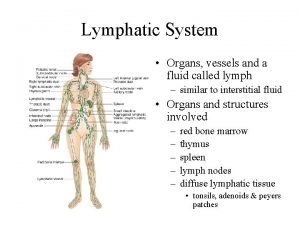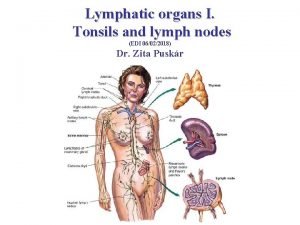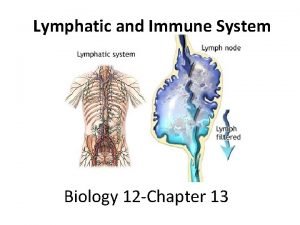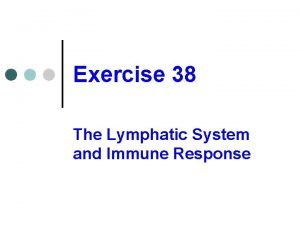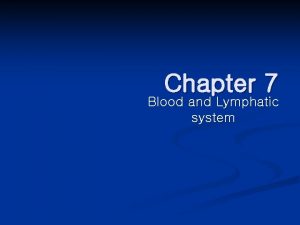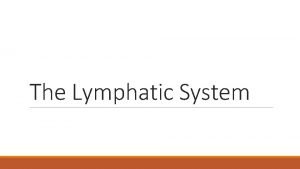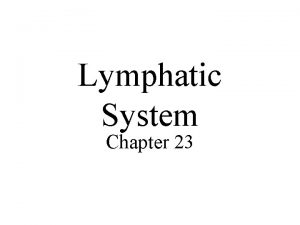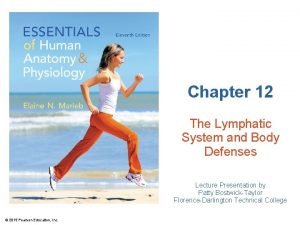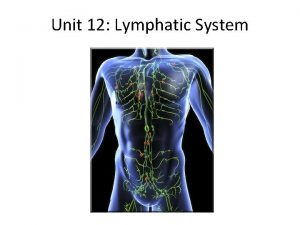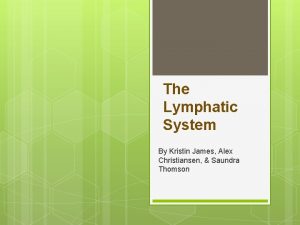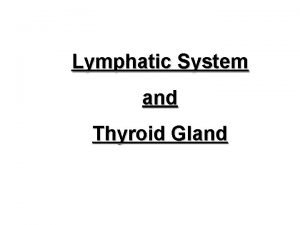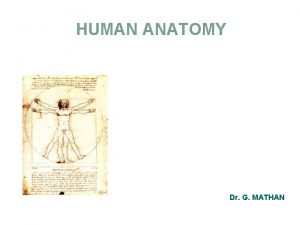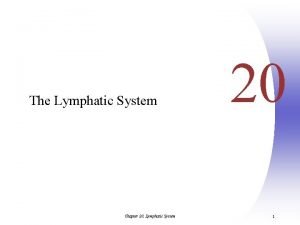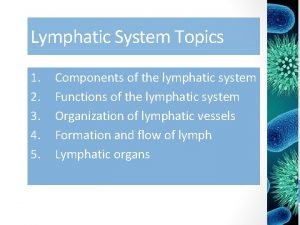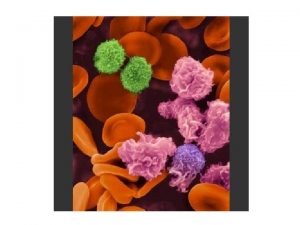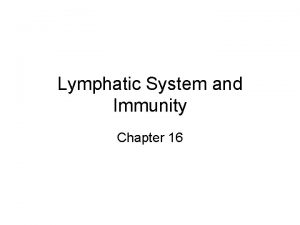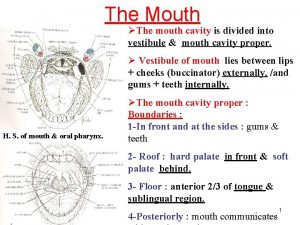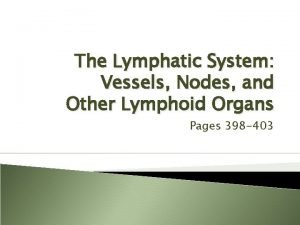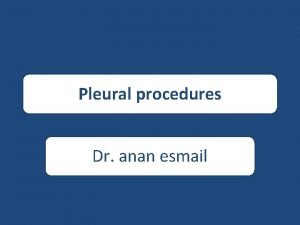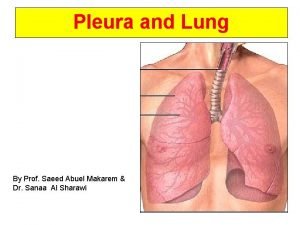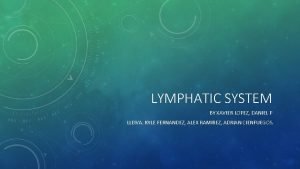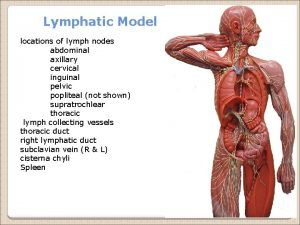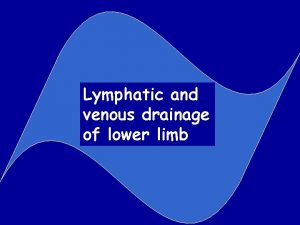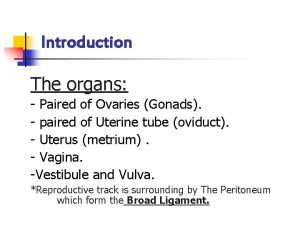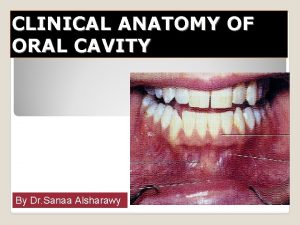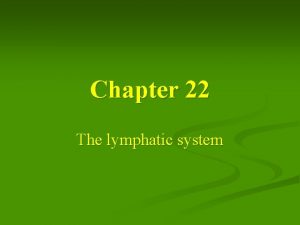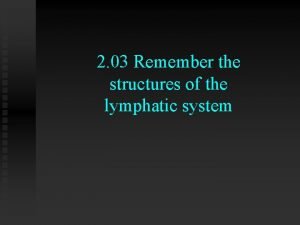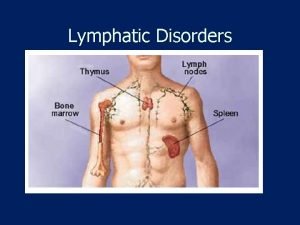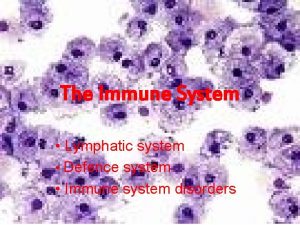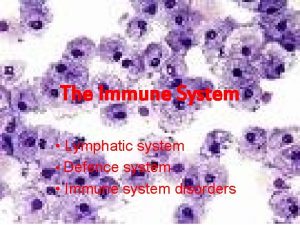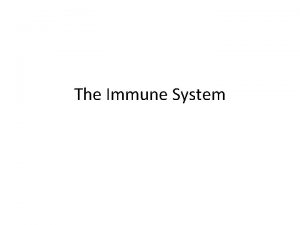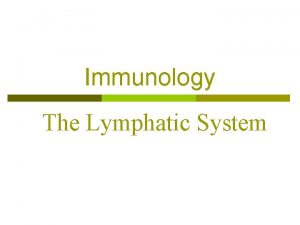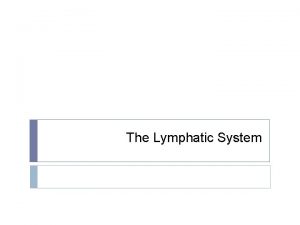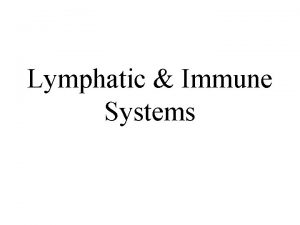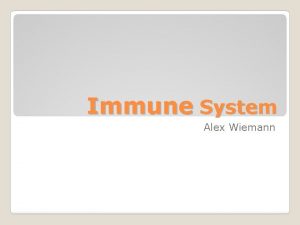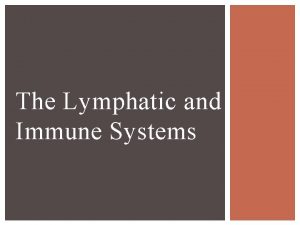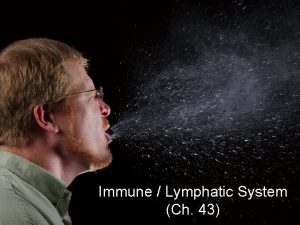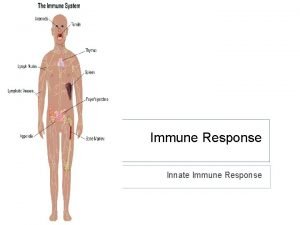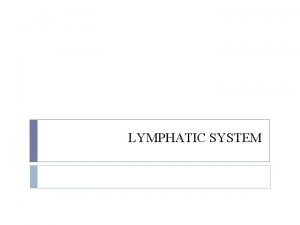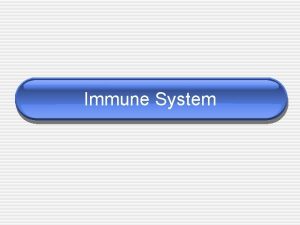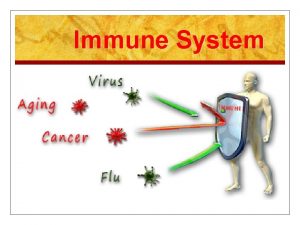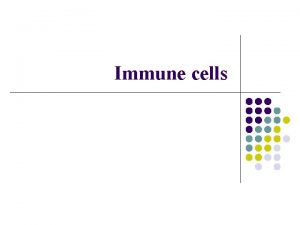Saladin Ch 21 Lymphatic Immune Systems Lymphatic System







![Lymph & Lymphatic Vessels – [Trunks: Lumbar, intestinal, subclavian bronchomediastinal, & juglar] – From Lymph & Lymphatic Vessels – [Trunks: Lumbar, intestinal, subclavian bronchomediastinal, & juglar] – From](https://slidetodoc.com/presentation_image_h2/d2e7e1cf236d360b90e602727fa25f25/image-8.jpg)




![Lymphatic Cells – Macrophages [Phago. & APC's] – Dendritic Cells [activate T cells - Lymphatic Cells – Macrophages [Phago. & APC's] – Dendritic Cells [activate T cells -](https://slidetodoc.com/presentation_image_h2/d2e7e1cf236d360b90e602727fa25f25/image-13.jpg)




























![Non-specific Disease Resistance – Lymphocytes - 3 classes [specific and non] 80% T, 15% Non-specific Disease Resistance – Lymphocytes - 3 classes [specific and non] 80% T, 15%](https://slidetodoc.com/presentation_image_h2/d2e7e1cf236d360b90e602727fa25f25/image-42.jpg)






































![Specific Immunity T-Cell Activation • Activation [clonal selection] – 2 steps – Recognition & Specific Immunity T-Cell Activation • Activation [clonal selection] – 2 steps – Recognition &](https://slidetodoc.com/presentation_image_h2/d2e7e1cf236d360b90e602727fa25f25/image-81.jpg)



























- Slides: 108

Saladin Ch. 21 Lymphatic & Immune Systems

Lymphatic System General • Lymphatic System - composed of lymph, lymphatic vessels, and lymphatic tissue • Functions of Lymphatic system functions – Draining of interstitial fluid – Transporting dietary lipids/lipid soluble vitamins from GI to blood. – Facilitating the Immune Response - by B and T lymphocytes.


Lymph & Lymphatic Vessels Lymph – Usually clear, colorless, derived from blood plasma but with less protein – Lacteals - specialized capillaries along the small intestine - pick up lipids - gives fluid white, opaque look = chyle – Contains large numbers of lymphocytes, etc.

Lymph & Lymphatic Vessels Lymphatic capillaries – Closed ends; One way flow - wall cells overlap; fluid pushes in & can separate the cells. – Anchoring filaments - hold capillaries in place & help open gaps when interstitial fluid builds up. – Location - not in cartilage, epidermis, CNS, parts of spleen or red marrow.


Lymph & Lymphatic Vessels Lymph trunk and ducts • In embryo form from buds from veins - similar structure. • Flow - capillaries into vessels into nodes. After passing through a string of nodes - goes into "trunks“
![Lymph Lymphatic Vessels Trunks Lumbar intestinal subclavian bronchomediastinal juglar From Lymph & Lymphatic Vessels – [Trunks: Lumbar, intestinal, subclavian bronchomediastinal, & juglar] – From](https://slidetodoc.com/presentation_image_h2/d2e7e1cf236d360b90e602727fa25f25/image-8.jpg)
Lymph & Lymphatic Vessels – [Trunks: Lumbar, intestinal, subclavian bronchomediastinal, & juglar] – From trunks, lymph flows into either the thoracic duct or the right lymphatic duct – From the ducts, flow is into venous blood

Lymph & Lymphatic Vessels • Right lymphatic duct – Drains from upper R side – Drains into R. subclavian vein – Trunk feeders - R juglar from R head and neck, R subclavian from R upper limb, R bronchmediastinal from R thorax.

Lymph & Lymphatic Vessels • Thoracic Duct - begins as cisterna chyli anterior to L 2 vertebra – Receives from left of head & neck, chest, left upper limb, & all of the body below the ribs. – Drains into the left subclavian vein – Feeder trunks - lower body -R & L lumbar, intestinal

Lymph & Lymphatic Vessels – Lumbars drain from lower limbs, pelvis, kidneys, adrenals & abdominal wall. – Intestinal drains from intestines, pancreas, spleen & liver – From the neck, the thoracic duct gets lymph from the l. juglar, l. subclavian, l. bronchomediastinal trunks

Lymphatic Cells • Lymphocytes - stem cells divide to produce B & T cells – Produced in red marrow – B cells may become plasma cells that produce antibody – Pluripotent cells in red marrow pre-T cells thymus to mature.
![Lymphatic Cells Macrophages Phago APCs Dendritic Cells activate T cells Lymphatic Cells – Macrophages [Phago. & APC's] – Dendritic Cells [activate T cells -](https://slidetodoc.com/presentation_image_h2/d2e7e1cf236d360b90e602727fa25f25/image-13.jpg)
Lymphatic Cells – Macrophages [Phago. & APC's] – Dendritic Cells [activate T cells - APC's] – Reticular cells – fibroblasts that produce reticular fibers for tissue “stroma”

Lymphatic Tissue • Aggregations of lymphocytes in connective tissues of mucus membranes • MALT, Galt, nodules, Peyer's patches

Malt – Peyer’s Patches

Lymphoid Organs • Include marrow, thymus, lymph nodes, spleen, tonsils • Red Bone Marrow --> lymphocytes [review blood chapter]

Lymphoid Organs • Thymus Gland – Functions in T cell maturation – Reticular epithelial cells produce thymic hormones that aid in maturation of T cells – Below sternum - large in infants, shrinks with age from puberty on. – 2 lobes – have capsule with trabeculae

Lymphoid Organs – Lobules - 2 regions - cortex and medulla • Cortex - deep staining - lymphocytes & reticular epithelial cells • Medulla - paler - mostly reticular epithelium fewer lymphocytes -Has thymic corpuscles [Hassall's] - concentric whorls of flattened reticular epithelium

Thymus

Lymphoid Organs • Lymph Nodes - about 600 bean-shaped organs – Concentrated in axillae, groin & near mammaries. – Function: • Trap material on reticular fibers, • Clear out foreign & damaged materials through phagocytosis, • Immune processes

Lymphoid Organs • Structure - stroma & parenchyma – Stroma - capsule - dense connective tissue covering - has trabeculae. Supports & holds vessels. Also has network of reticular fibers & fibroblasts.

Lymphoid Organs – Parenchyma - 2 regions - cortex and medulla • Cortex - outer and inner – Outer - lymphatic nodules of B cells. Germinal centers - where B cells proliferate into plasma cells. Dendritic cells - APC's initiate immune response. Also have macrophages. – Inner - T-cells

Lymph Node

Lymphoid Organs • Medulla – B & T cells, plasma cells tightly packed in "medullary cords“ – Lymph nodes have unidirectional flow - enters through afferent vessels sinuses efferent lymphatic vessels. [Hilus - place where efferent vessels emerge. ] – Lymph flows through a series of nodes --> quite clean at the end.


Lymphoid Organs • Metastasis - spread of cancer. – Sites for metastasis are predictable based on lymphatic flow patterns. – Conversely, when a secondary tumor is found, the primary can usually be located by going in reverse back the flow paths.

Lymphoid Organs • Tonsils – Pharyngeal = adenoid, palatine =at base of palatine bones, lingual = base of tongue, tubal = around auditory tube openings – No capsule – “crypts” that trap bacteria & particulate material

Tonsils

Lymphoid Organs • Spleen - largest lymphatic structure - between stomach & diaphragm. – Function: • Immunologic – precipitate, kill antigens • Clean up old rbc’s, • Store platelets, • Stabilize blood volume

Lymphoid Organs • Parenchyma – White pulp - Lymphocytes & macrophages – Red pulp – venous sinuses filled with blood & Billroth’s [splenic] cords [rbc’s, macrophages, lymphocytes, B cells, granulocytes pressed together]

Lymphoid Organs • Stroma – Capsule with trabeculae covered, with serous visceral peritoneum. – Interior reticular tissue.


Non-specific Disease Resistance • Non-specific Resistance to Disease –> immediate protection against a wide variety of pathogens & foreign substances – NO memory – always the same – Pathogen = a disease-causing agent

Non-specific Disease Resistance – Lines of Defense: 1 - external barriers - non-specific 2 - non-specific internal responses 3 - immune system - specific

Non-specific Disease Resistance • External Barriers Skin & Mucous Membranes – Mechanical factors – physical barriers – intact skin, tight junctions – Mucous membranes – physical barriers also – mucous catches dirt, etc. ; hairs filter out material, cilia sweeps out invaders


Non-specific Disease Resistance • Chemical Factors: – Defensins – p. H of skin [3 -5] antimicrobial – Sweat – flushes, contains lactic acid = acid mantle

Non-specific Disease Resistance – Tears – dilute agents. Also some lysozyme antibiotic properties – Saliva – same Urine / vaginal secretions – Dermal hyaluronic acid - viscous - hard to traverse Some organisms have hyaluronidase to dissolve it.

Non-specific Disease Resistance • Internal Defenses - Leukocytes & Macrophages Phagocytes – eat foreign matter – Neutrophils – in most body tissues. In addition to phagocytosis, use respiratory burst - series of reactions/agents that create H 2 O 2, HCl. O & superoxide ions that destroy bacteria

Non-specific Disease Resistance – Eosinophils – can attack parasitic worms, promote basophil action, reduce inflammatory response – Basophils - secrete histamine - vasodilator and Heparin - anticoagulant [both also released by mast cells].

![Nonspecific Disease Resistance Lymphocytes 3 classes specific and non 80 T 15 Non-specific Disease Resistance – Lymphocytes - 3 classes [specific and non] 80% T, 15%](https://slidetodoc.com/presentation_image_h2/d2e7e1cf236d360b90e602727fa25f25/image-42.jpg)
Non-specific Disease Resistance – Lymphocytes - 3 classes [specific and non] 80% T, 15% B, 5% NK – Monocytes – Special "macrophages" - dendritic cells, microglia, alveolar, hepatic


Non-specific Disease Resistance • Internal Defenses - Antimicrobial Proteins – Interferons – produced by virally infected lymphocytes, macrophages, & fibroblasts • Attach to uninfected cells & induce synthesis of proteins that interfere with viral replication • Protects these cells from infection • Also activate NK cells


Non-specific Disease Resistance – Complement – a group of 30+ proteins that are synthesized by the liver & in the blood normally inactivated • When activated – enhance all parts of the immune response as well as allergic responses • Activated 3 ways - complement fixation [Ab], alternative path [ spontaneous - no Ab], Lectin path - attach to sugars on microbes

Non-specific Disease Resistance – 4 methods. • Inflammation - C 3 a stimulates mast and basophils to release histamine and initiate the IR, activates & attracts neutrophils • Immune Clearance - C 3 b - binds Ab-Ag complexes to rbc's - collected by macrophages in liver & spleen

Non-specific Disease Resistance • Phagocytosis - opsonization by C 3 b • Cytolysis - C 3 b initiated. --> cascade -->makes a hole in membrane of target cell


Non-specific Disease Resistance • Immune Surveillance – NK cells patrol foreign agents and diseased host cells - destroy them – Use perforins + granzymes

Non-specific Disease Resistance • Inflammation – tumor, rubror, calor and pain – 3 stages – mobilization = vasodilation and increased permeability, emigration, containments & destruction, tissue repair [see table 21. 1 for cells and chemicals]

Non-specific Disease Resistance • Sequence of inflammation events – Vasodilation • Causes – normal or damaged cells release histamine & other vasoactive chemicals --> • Dilation & increased permeability --> redness, heat & swelling

Non-specific Disease Resistance – Emigration - Neutrophils, then macrophages come into clean up - Attracted by cytokines • Margination – neutrophils in vessels adhere to walls of vessel near injury due to selectins • Diapedesis – neutrophils leave vessels

Non-specific Disease Resistance • Chemotaxis – neutrophils outside vessels attracted to site of injury • Pain is produced from damaged sensors or irritation by toxic substances & bradykinin. Prostaglandins also increase pain



Non-specific Disease Resistance – Containment • Blood clotting factors reach site and form clot – walls off injured area • Anticoagulants prevent clot at immediate entry area - enhances clearance by leukocytes • Chemotaxis brings neutrophils, then and other macrophages --> rapid increase in neutrophils

Non-specific Disease Resistance – Tissue Cleanup & Repair • Monocytes do phagocytosis & are Agpresenting cells • Pus forms [dead material] – Ulcer – open edge, abscess – all enclosed • Platelet-derived growth factor stimulates fibroblasts --> collagen --> scaffold for new cells

Non-specific Disease Resistance • Fever – increase in body temperature produced by the hypothalamus – In response to pyrogens secreted by leukocytes and macrophages – Accompanies infection and inflammation – Promotes interferon production, inhibits bacterial growth, speeds up metabolism --> faster repair

Non-specific Disease Resistance – Reye Syndrome • Children less than 15 yo - with acute viral infection - brain swelling, etc. • Can be triggered by use of aspirin.

Specific Immunity • General Aspects of Specific Immunity – Immunity is systemic – body-wide – Immunity is specific - ability of the body to defend itself against specific invading agents such as bacteria, toxins, viruses & alien tissues.

Specific Immunity – Requires initial exposure before can develop "memory" of the agent remains after infection--> continued defense. – Antigens [Ag] are substances that provoke such an immune response [usually “foreign”]

Specific Immunity • Forms of Immunity – 2 classes of response: • Cell-mediated – cells [lymphocytes] attack other cells. – Intracellular agents • Humoral Response – antibody-mediated. Ab usually in body fluids. Extracellular agents & molecular pathogens

Specific Immunity – Active versus Passive Immunity • Active – make our own Ab/T cells – Natural – infection/exposure to fully active Ag B and T cell memory – Artificial – vaccination [mostly B cell responses – not T]

Specific Immunity • Passive – get Ab from elsewhere – Natural – maternal – placenta & milk – Artificial – pooled gamma globulin

Specific Immunity Ag’s - trigger immune responses • Immunogenicity – ability to provoke either a T or B cell response • Reactivity – ability of Ag to react with Ab or cells provoked • If an Ag does both it is “complete Ag”

Specific Immunity • Ag’s include whole or parts of microbes, bacterial toxins, pollen, egg white, blood cells, tissues • Large molecules made of small repeating units usually evoke no response • Hapten – a substance that cannot evoke a response by itself, but can if bound to something else [e. g. , a cell receptor].

Specific Immunity • Antigenic Determinants = epitopes – specific regions of Ag molecules that trigger a response – Many / Ag – thus for a given invader – get a variety of Ab’s per Ag

Specific Immunity Lymphocytes - Cells of the Immune System • Develop from pluripotent red marrow cells • 3 populations of lymphocytes – NK, B’s and T’s • T’s cells leave marrow and go to the thymus for final processing by thymic hormones

Specific Immunity – Becoming immunocompetent means being able to recognize a foreign antigen & not responding to self-antigens. Tested for self-recognition • 1) must be able to bind MHC molecules bearing Ag presented for recognition, & • 2) must NOT react with “self” Ag. If they do, they are eliminated. Those that pass --> clones

Specific Immunity • B’s mature into “immunocompetent” cells in the marrow throughout life humoral responses [Develop receptors for 1 AG – receptors are AB’s. ] – B cells that recognize self-antigens are either inactivated in the marrow, or killed • Each individual B or T cell is genetically programmed to recognize only one antigenic determinant

Specific Immunity Antigen-Presenting Cells - Pathway of Ag processing for response • T cells usually need help recognizing Ag, they require APC's - B cells, or macrophages, or reticular cells, or dendritic cells.

Specific Immunity • Self-Ag’s - Major Histocompatibility Complex = MHC – On membrane surfaces – glycoproteins – Also called HLA Ag’s – first found on wbc’s – Unique - usually recognize them before birth & don't attack

Specific Immunity • APC’s engulf foreign particles & then present fragments on their own cell surfaces, “signal flags. ” – Strategically located so as to ensure coverage of all body parts & tissues – Secrete proteins interleukins that activate T cells & stimulate killer cells • T-cells circulate [enhances chances of encountering the AG]


Specific Immunity Cell-Mediated Immunity – Targets body cells infected with viruses or bacteria, abnormal or cancerous cells, & foreign transplants • T cells classed by type of “cell differentiation” glycoprotein on their surfaces – CD 4 - helper T cells – CD 8 - cytotoxic T cells

Specific Immunity Recognition: • T cells only “recognize” processed fragments of protein Ag’s displayed on cell surfaces • Antigen Recognition and MHC Restriction – 2 types of MHC’s are important to T cell activation • MHCI are found on all self cells except red blood cells

Specific Immunity – Pick up endogenous materials on way to surface - display them. If Ag is foreign material from inside cells [e. g. , viral protein], it is recognized – T cells [Tc]kill the cell showing it


MHCII – on mature B, T & APC’s – have exogenous engulfed & digested Ag [not self] - Th respond
![Specific Immunity TCell Activation Activation clonal selection 2 steps Recognition Specific Immunity T-Cell Activation • Activation [clonal selection] – 2 steps – Recognition &](https://slidetodoc.com/presentation_image_h2/d2e7e1cf236d360b90e602727fa25f25/image-81.jpg)
Specific Immunity T-Cell Activation • Activation [clonal selection] – 2 steps – Recognition & binding to presented complex by a specific T-cell receptor – Co-stimulation – required second signal – from cytokines, & plasma membrane molecules on APC’s


Specific Immunity – Proliferation and Differentiation • After activation – T cell enlarges & divides several times • Forms more highly specialized T-cells in clones • Activation and proliferation etc. occurs in secondary lymphatic organs & tissues – tonsils, lymph nodes, etc.

Specific Immunity Attack • Helper = TH or T 4 – essential to specific immunity. – Interact with both T & B cells & macrophages. • Recognize MHCII presented Ag. Activated by APC’s – When activated, secrete interleukins which attract neutrophils & NK's, stimulate phagocytosis, & stimulate clone formation

Specific Immunity • Cytotoxic = TC or T 8 = Killer T cells – Recognize MHCI bound Ag [viral, tumor, transplant] – TC – attach to invader – use Perforin – pokes holes in target cell’s membrane => lysis, interferons, & tumor necrosis factor [kills cancer cells]

Specific Immunity Memory • T Cells– left over after cell-mediated response is done can initiate a new response if the Ag reappears

Specific Immunity Humoral Immunity Recognition • B Cells - each has receptors to only one Ag • B cell Ag receptors bind to Ag – several pieces link together & are then endocytosed through receptor mediated process

Specific Immunity • The activation response is stronger if neighboring dendritic cells also process &present the Ag • Ag taken in by B cell, broken down, & moved to the B cell membrane • This results in co-stimulation by helper T's to proliferate & form clones


Specific Immunity • Activated B cells from the clone enlarge & become plasma cells – secrete Ab at rate of 2000 molecules per second per cell for 4 to 5 days • Some activated B cells become memory cells instead of plasma cells

Specific Immunity Attack • Ab’s – match antigenic determinants that stimulate their production • Also called immunoglobulins = gamma globulin fraction of blood

Specific Immunity • Ab structure – glycoproteins = carbohydrate & protein – 2 heavy chains – 2 light chains – Disulfide bridges hold L to H and H to H

Specific Immunity – 2 regions per H & L chain pair • Variable – Ag binding site – recognizes determinant • Constant – same for most Ab of a given class – different among classes [especially the H chains]

Ab Structure

Specific Immunity Ab classes – 5 groups classed by their constant regions [Table 21. 3]. • Ig. G – 80% - antibacterial, antiviral, opsonizing, neutralizing, complement trigger. Monomer. Can cross placenta • Ig. A – 1 -15% - sweat, tears, saliva, mucus, milk, GI. Monomer & dimer

Specific Immunity • Ig. M – 5 -10% Activates complement, agglutinates, anti-ABO Ab’s in plasma. Pentamer. [Can fix complement. ] • Ig. D – 0. 2% Monomer. Ag receptors on B cells • Ig. E – Bound to basophils and mast cells. Allergic & hypersensitivity reaction. Protects from worms. Monomer.



Specific Immunity Mechanisms of Ab Diversity • Humans can produce from 10 billion to a trillion different Ab's • Have about 100, 000 genes to code for Ab proteins • Composed of “bits” put together in different combinations by “somatic recombination” • H & L chain exons on same chromosome

Specific Immunity Ab Actions – inactivate and tag for destruction • Neutralization – bind to & block antigen/toxin • Agglutination/ precipitation –clumping • Complement Fixation • Complement also stimulates inflammatory response in region, Opsonization – coat & make sticky to phagocytes

Agglutination Neutralization

Specific Immunity Memory • Both long lasting Ab & memory cells • Primary response [first exposure] – takes a few days to see Ab • Ab levels increase, then drop but memory cells remain • Second response produces more & more effective Ab

Specific Immunity Immune System Disorders • Allergy – hypersensitivity. One system has 4 types: – Type I = immediate [acute] - hay fever, etc. Anaphylactic shock can occur. – Type II - antibody-dependent cytotoxic [Ab opsonizes or complement fixation] Transfusion reactions, some drug reactions


Specific Immunity – Type III - Immune complex - precipitate in tissue, then activate complement, leading to tissue damage. Autoimmune SLE & Glomerulonephritis – Type IV - Delayed – cell-mediated. Poison ivy, graft rejection

Specific Immunity Autoimmune Diseases • Failures of self-tolerance • 3 causes - cross-reactivity [e. g. , strep], abnormal exposure to occult Ag [usually sequestered]Hashimoto's thyroiditis], Change in self-Ag structure [type I diabetes]


Specific Immunity • Immunodeficiency Diseases – SCID - "boy in bubble“ – AIDS - review on own
 Chapter 24 the immune and lymphatic systems and cancer
Chapter 24 the immune and lymphatic systems and cancer The lymphatic capillaries are
The lymphatic capillaries are Primary immune response and secondary immune response
Primary immune response and secondary immune response Lymphatic vs immune system
Lymphatic vs immune system Phagocitize
Phagocitize Muslim saladin retakes jerusalem
Muslim saladin retakes jerusalem What is the first line of defense
What is the first line of defense What is the third line of defense in the immune system
What is the third line of defense in the immune system Hangman flowchart
Hangman flowchart Third line of defense immune system
Third line of defense immune system 1st line of defense immune system
1st line of defense immune system Chapter 35 immune system and disease
Chapter 35 immune system and disease 1st 2nd and 3rd line of defense immune system
1st 2nd and 3rd line of defense immune system Ap biology immune system
Ap biology immune system Lesson 12.1 lymphatic ducts and vessels
Lesson 12.1 lymphatic ducts and vessels Lesson 12 blood and immune system
Lesson 12 blood and immune system Immune system lymph nodes
Immune system lymph nodes Immune system def
Immune system def Overreactions of the immune system
Overreactions of the immune system Defination of infection
Defination of infection The main function of immune system
The main function of immune system Malt anatomy
Malt anatomy Thymus immune system
Thymus immune system Immune complex
Immune complex Thalassemia autosomal recessive
Thalassemia autosomal recessive 1what's the purpose of the body's immune system?
1what's the purpose of the body's immune system? Lympathic
Lympathic Lymphatic system organs and functions
Lymphatic system organs and functions Non immune hydrops fetalis
Non immune hydrops fetalis Primary vs secondary immune response
Primary vs secondary immune response Chapter 55 care of the patient with an immune disorder
Chapter 55 care of the patient with an immune disorder Immune checkpoint inhibitors mechanism of action
Immune checkpoint inhibitors mechanism of action Immune reconstitution inflammatory syndrome
Immune reconstitution inflammatory syndrome Predeksihkhariini
Predeksihkhariini Immune complex glomerulonephritis
Immune complex glomerulonephritis Tim-3
Tim-3 Primary immune response
Primary immune response Immune effector cells
Immune effector cells Unsaturated alcohol crossword clue
Unsaturated alcohol crossword clue Hepatite auto immune fmc
Hepatite auto immune fmc Antigen defintion
Antigen defintion Lupus
Lupus Primary and secondary immune response
Primary and secondary immune response Biosimilar study
Biosimilar study Adcc immune
Adcc immune Passive vs active immunity
Passive vs active immunity Types of immune
Types of immune Immune reconstitution therapy
Immune reconstitution therapy Type of muscle
Type of muscle Maladie auto immune connectivite
Maladie auto immune connectivite Immune thrombocytopenic purpura
Immune thrombocytopenic purpura Immune complex
Immune complex Hit heparin
Hit heparin Sspe vaccine
Sspe vaccine Venous drainage
Venous drainage What are the function of lymphatic system
What are the function of lymphatic system Chapter 12 the lymphatic system and body defenses
Chapter 12 the lymphatic system and body defenses Functions of the lymphatic system
Functions of the lymphatic system Cardiovascular/lymphatic system it's totally tubular
Cardiovascular/lymphatic system it's totally tubular Largest lymphoid organ
Largest lymphoid organ Crumo cell
Crumo cell Lymphatic system is composed of
Lymphatic system is composed of Chapter 10 lymphatic system diseases and disorders
Chapter 10 lymphatic system diseases and disorders Infraclavicular node
Infraclavicular node Integumentary interactions with other systems
Integumentary interactions with other systems Hemic and lymphatic
Hemic and lymphatic Umbilicus lymphatic drainage
Umbilicus lymphatic drainage Organization of the lymphatic system
Organization of the lymphatic system Lymphatic system organs
Lymphatic system organs Test chapter 7:9 lymphatic system
Test chapter 7:9 lymphatic system Reticular cell
Reticular cell Chapter 13 lymphatic system and immunity
Chapter 13 lymphatic system and immunity Exercise 38
Exercise 38 Chapter 7:9 lymphatic system
Chapter 7:9 lymphatic system Flaplike minivalve
Flaplike minivalve Short tube that receives purified lymph
Short tube that receives purified lymph Spleen
Spleen Quizlet
Quizlet Photo of lymphatic system
Photo of lymphatic system Lymph composition
Lymph composition Interesting facts about the lymphatic system
Interesting facts about the lymphatic system Lymph node
Lymph node Function of skeletal muscle
Function of skeletal muscle Lymphatic system picture
Lymphatic system picture Flow chart of lymphatic system
Flow chart of lymphatic system Lymphatic system lecture
Lymphatic system lecture Lymph composition
Lymph composition Chapter 12 the lymphatic system and body defenses
Chapter 12 the lymphatic system and body defenses Chapter 16 lymphatic system and immunity
Chapter 16 lymphatic system and immunity Chapter 7:9 lymphatic system
Chapter 7:9 lymphatic system Decision support systems and intelligent systems
Decision support systems and intelligent systems Principles of complex systems for systems engineering
Principles of complex systems for systems engineering Embedded systems vs cyber physical systems
Embedded systems vs cyber physical systems Engineering elegant systems: theory of systems engineering
Engineering elegant systems: theory of systems engineering Palatine aponeurosis
Palatine aponeurosis Lymph node diagram
Lymph node diagram Bean size lymph node
Bean size lymph node Figure 12-1 provides an overview of the lymphatic vessels
Figure 12-1 provides an overview of the lymphatic vessels Parietal pleura lymphatic drainage
Parietal pleura lymphatic drainage Lymphatic drainage of pleura
Lymphatic drainage of pleura Xavier daniel lopez
Xavier daniel lopez Internal naris
Internal naris Posterior arch vein
Posterior arch vein Lymphatic drainage of vulva
Lymphatic drainage of vulva Lymphatic drainage of tongue
Lymphatic drainage of tongue Largest lymphatic duct
Largest lymphatic duct The lymphatic structure that closely parallel veins
The lymphatic structure that closely parallel veins Efferent lymphatic vessel
Efferent lymphatic vessel Lymphatic drainage massage buttocks
Lymphatic drainage massage buttocks



